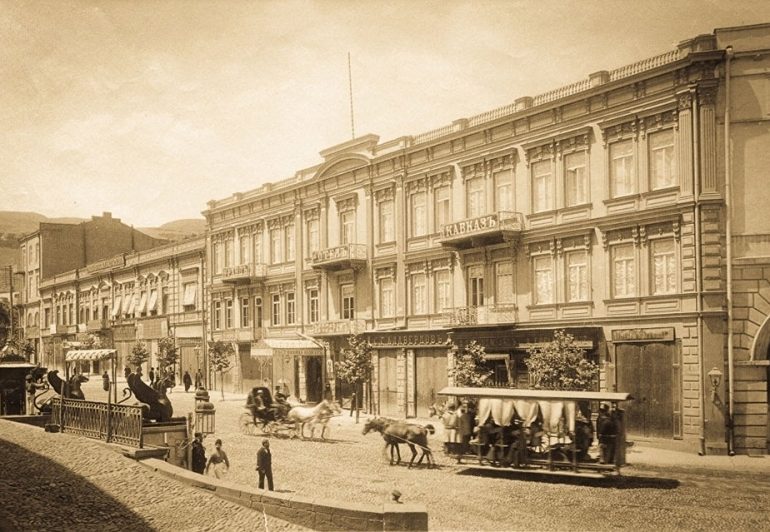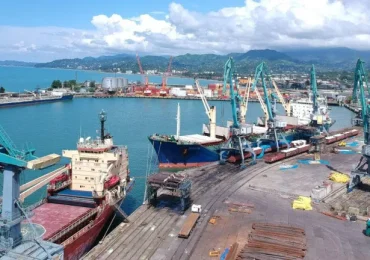The first hotel in Tbilisi opened in 1818. The proprietor of this hotel was a Frenchman, who happened to be a former soldier in Napoleon’s army.
Interestingly enough, there is no record of his last name. We only know that his first name was Jean Paul. His hotel was located in Kala, in the Old Town on a streetknown to many at the time as “the muddy street”. This street is now named after Alexander Duma.
A whole chain of hotels was in the process of development at the beginning of the 19th century in Tiflis. However, all these hotels had one common feature: none of the buildings that were transformed into hotels had originally been built for that purpose. It was very common for aspiring hoteliers to rent beautiful buildings in the central district of Tiflis.
The Zaltsman Hotel was probably one of the most distinguished hotels at the time. It was located in Rike,on the left bank of the Mtkvari River. The Rike district was very unique at the time, since the houses located in this district were built by German settlers. Theodor (Friedrich) Zaltsman turned the house that he had built for himself into a hotel.
Another interesting German-owned hotel was called ‘Vetzel’ and it was located on Mickeil Avenue (currently Davit Aghmashenebeli Avenue 103).Jakob Friedrich (1835-1904) was the most successful member of the Vetzel family. He owned a beer factory, a hotel, as well as real estate in Tbilisi and its suburbs (Kojori and Tsavkisi). Friedrich Vetzel was a 2nd Gild merchant and for some time he was even a member of the city council. In the 1870s, Friedrich Vetzel opened a beer factory together with his brother Johan Caspar. The factory was located on Great Noble Street (currently Uznadze Street). In addition to the brewery, the Vetzel family also owned a beer restaurant.
The hotel that caught our attention was built by Friedrich Vetzel between 1897 and the early 1900s. It was located on a land plot owned by Vetzel at the junction of Mickeil Avenue and Ksenia Street (currently Zakaria Chavchavadze Street).The project was carried out by Tbilisi-based German architect Leopold Bielefeld (1838-1921). The hotel had all the amenities available at the time. Each room had water heating and electricity; there was also an elevator, a billiard room, a kegelbahn and two restaurants. What made this hotel even more distinguished was the theatre that was located in the left section of the building.
London (Hotel de Londres) opened in 1875 at 21 Madatov Street (currently 31 Atoneli Street). Initially this territory belonged to Alexander Zubalashvili and later it was owned by his brother Constantine Zubalashvili. At the beginning of the 20th century, after Constantine Zubalashvili passed away, his third son Petre inherited this territory. One of the main attractions of the Londonbuilding was its lobby and the stairs. The London hotel was rather small: in 1896 it had only 28 rooms and the price per day ranged from one to ten manats. In 1914, two more suits were added to the hotel. The golden age for the London hotel was in the 1880s and 1890s.During this period, the hotel hosted wealthy foreign travellers and honorable guests from Russia, Europe and the near east, such as the Russian composer Peter Tchaikovsky (1888), George Curzon, who was later the viceroy of India and Minister of Foreign Affairs of Britain (1892), as well asrenowned Norwegian writer Knut Hamsun (1899).
In 1881, Hector Delaland opened the Grand-Hotelat the so-called Mirzoev house, which was located just across the street from hotel London. The Grand-Hotel took only half of the building; the rest of the building housed various shops and the office of the Insurance Society ‘Anchor’ (Якорь). The hotel is now a residential building located at 29 Atoneli Street/1 Khidi Street.
It should be noted that the popularity of these two hotels was rather short-lived. There were many reasons for that. The territory adjacent to the Madatov island was not considered the central part of the city at the time. Moreover, the buildings where London and the Grand-Hotel were located were not large enough to meet the tourist and commercial demands of Tiflis at the turn of the 19th and 20thcenturies. Large-scale hotel complexes started to emerge in Tiflis in the beginning of the 20th century. Well-known benefactor and entrepreneur Mikael Aramyants, built a luxury hotel on the Golovin Avenue (currently Rustaveli Avenue), which was named ARFASTO, an acronym denoting the first names of his children, Aram, Flora, Soghomon, Anna and Hovhannes. Today this building housesthe Shota Rustaveli Theater and Georgia State Film University.
Later, Aramyants decided to launch an even more grandiose project on Golovin Avenue. Aramyants built a house that was located at the intersection of Golovin and Baryatinski streets. The house belonged to Rotinov and it housed an atelier owned by photographer Petre Gankevich. Aramyants hired the most prominent architect in Tiflis and Baku –Gabo Ter-Mikelov. Aramyants sent Ter-Mikelov to Europe to work on the project. In 1915.The Majestic Hotel was built on Golovin Avenue, which is currently the Tbilisi Marriott. The construction of the hotel was very costly, since the building had a rounded shape.
Kavkaz (Caucasus), another famous hotel, was located in the vicinity of these two hotels. Hotel Kavkaz was located on Freedom Square, or to be more precise at the site where Hotel Courtyard Marriott is currently situated. The first floor of the hotel housed stores and the hotel itself was famous for its high-quality service.
In addition to the above-listed hotels, there were many other less known hotels in Tiflis, such as the Sabaduri, whichwas located at 19 Rustaveli Avenue. We come across some description of this hotel in old newspapers, however, the description was rather limited and lacked much detail. Unlike hotel Sabaduri, the description of the hotel Pur-Ghvino (Bread-Wine) was rather loquacious and provides detailed information about the services it provided: “two course meal 12 manats per month and 18 manats for three months. For those who wish to be served wine, vodka and coffee, we can make a special offer.”
In the 1890s a newspaper advertisement for the Abasha Hotel, which was located near the modern railway station, informed readers that the price for rooms at this hotel ranged from 60 kapeika to 1.5 manat.
This is just a short list of the hotels that were operated in Tiflis in the early 19th and late 20 centuries.
Article in Georgian.

















